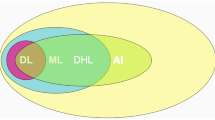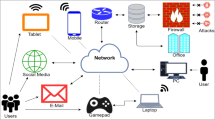Abstract
In the past few years, the Industrial Internet of Things (IIoT) started to emerge in different industry sectors. IIoT connects different physical equipment and systems in order to operate more efficiently. As the systems work simultaneously, the amount of data they produce and share increases resulting in more vulnerability against cyber and physical attacks. Since security is one of the major challenges in IIOT, this paper proposes a Machine Learning- based technique in order to detect cyber-attacks on IIoT systems., A Snapshot Ensemble Deep Neural Network (SEDNN) has been utilized and evaluated various metrics, including accuracy, precision, recall, and F1-score. The proposed model obtained an accuracy of 90.58% for cyber-attack detection. Also, precision, recall, F1-score are 87.42%, 93.77% and 90.48%, respectively.
Access this chapter
Tax calculation will be finalised at checkout
Purchases are for personal use only
Similar content being viewed by others
References
E. Borgia, “The Internet of Things vision: Key features, applications and open issues,” Comput. Commun., vol. 54, pp. 1–31, 2014, https://doi.org/10.1016/j.comcom.2014.09.008.
A. Alabasi, H. Karimipour, A. Dehghantanha, “An Ensemble Deep Learning-based Cyber-Attack Detection in Industrial Control System”, IEEE Access, vol. 8, pp. 83965-83973, April. 2020. doi: https://doi.org/10.1109/ACCESS.2020.2992249.
J. Lin, W. Yu, N. Zhang, X. Yang, H. Zhang, and W. Zhao, “A Survey on Internet of Things: Architecture, Enabling Technologies, Security and Privacy, and Applications,” IEEE Internet Things J., vol. 4, no. 5, pp. 1125–1142, 2017, doi: https://doi.org/10.1109/JIOT.2017.2683200.
V. V Potekhin, A. H. Bahrami, and B. Katalinič, “Developing manufacturing execution system with predictive analysis,” IOP Conf. Ser. Mater. Sci. Eng., vol. 966, p. 12117, 2020, doi: https://doi.org/10.1088/1757-899x/966/1/012117.
J. Sakhnini, H. Karimipour, A. Dehghantanha, R. Parizi, G. Srivastava “Security Aspects of Internet of Things Aided Smart Grids: a Bibliometric Survey”, Internet of Things Journal—Elsevier, pp. 1–15, Sept. 2019. https://doi.org/10.1016/j.iot.2019.100111
F. Anwaar, N. Iltaf, H. Afzal, and R. Nawaz, “HRS-CE: A hybrid framework to integrate content embeddings in recommender systems for cold start items,” J. Comput. Sci., vol. 29, pp. 9–18, 2018, doi: https://doi.org/10.1016/j.jocs.2018.09.008.
S. M. Tahsien, H. Karimipour, P. Spachos, “Machine Learning Based Solutions for Security of Internet of Things (IoT): A Survey”, Journal of Network and Computer Applications—Elsevier, vol. 161, pp. 1–18, April. 2020. https://doi.org/10.1016/j.jnca.2020.102630
A. Yazdinejad, R. M. Parizi, A. Dehghantanha, H. Karimipour, G. Srivastava, and M. Aledhari, “Enabling Drones in the Internet of Things with Decentralized Blockchain-based Security,” IEEE Internet of Things Journal, 2020.
E. Nowroozi, A. Dehghantanha, R. M. Parizi, and K.-K. R. Choo, “A survey of machine learning techniques in adversarial image forensics,” Computers & Security, vol. 100, p. 102092, 2021.
A. Yazdinejad, G. Srivastava, R. M. Parizi, A. Dehghantanha, H. Karimipour, and S. R. Karizno, “SLPoW: Secure and Low Latency Proof of Work Protocol for Blockchain in Green IoT Networks,” in 2020 IEEE 91st Vehicular Technology Conference (VTC2020-Spring), 2020, pp. 1–5: IEEE.
M. Aledhari, R. M. Parizi, A. Dehghantanha and K. R. Choo, “A Hybrid RSA Algorithm in Support of IoT Greenhouse Applications,” 2019 IEEE International Conference on Industrial Internet (ICII), Orlando, FL, USA, 2019, pp. 233–240, https://doi.org/10.1109/ICII.2019.00049
A. Yazdinejadna, R. M. Parizi, A. Dehghantanha, and M. S. Khan, “A kangaroo-based intrusion detection system on software-defined networks,” Computer Networks, vol. 184, p. 107688, 2021.
A. Yazdinejad, R. M. Parizi, A. Dehghantanha, and K.-K. R. Choo, “Blockchain-enabled authentication handover with efficient privacy protection in SDN-based 5G networks,” IEEE Transactions on Network Science and Engineering, 2019.
M. Aledhari, R. Razzak, R. M. Parizi and F. Saeed, “Federated Learning: A Survey on Enabling Technologies, Protocols, and Applications,” in IEEE Access, vol. 8, pp. 140699–140725, 2020, doi: https://doi.org/10.1109/ACCESS.2020.3013541
A. Yazdinejad, G. Srivastava, R. M. Parizi, A. Dehghantanha, K.-K. R. Choo, and M. Aledhari, “Decentralized authentication of distributed patients in hospital networks using blockchain,” IEEE journal of biomedical and health informatics, vol. 24, no. 8, pp. 2146–2156, 2020.
H. M. Ruzbahani and H. Karimipour, “Optimal incentive-based demand response management of smart households,” in 2018 IEEE/IAS 54th Industrial and Commercial Power Systems Technical Conference (I&CPS), 2018, pp. 1–7, https://doi.org/10.1109/ICPS.2018.8369971.
H. M. Ruzbahani, A. Rahimnejad, and H. Karimipour, “Smart Households Demand Response Management with Micro Grid,” in 2019 IEEE Power & Energy Society Innovative Smart Grid Technologies Conference (ISGT), 2019, pp. 1–5, https://doi.org/10.1109/ISGT.2019.8791595.
E. Modiri, A. Azmoodeh, A. Dehghantanha, H. Karimipour, “Fuzzy Pattern Tree for Edge Malware Detection and Categorization in IoT”, Journal of Systems Architecture, vol. 9, pp. 1–7, Jan. 2018. https://doi.org/10.1016/j.sysarc.2019.01.017
Z. Ling, J. Luo, Y. Xu, C. Gao, K. Wu, and X. Fu, “Security Vulnerabilities of Internet of Things: A Case Study of the Smart Plug System,” IEEE Internet Things J., vol. 4, no. 6, pp. 1899–1909, 2017, doi: https://doi.org/10.1109/JIOT.2017.2707465.
M. Hazrati, H. Karimipour, A. N. Jahromi, A. Dehghantanha, “Ensemble sparse representation-based cyber threat hunting for security of smart cities”, Computer & Electrical Engineering Journal- Elsevier (IF: 2.6), Dec. 2020. https://doi.org/10.1016/j.compeleceng.2020.106825
G. Apruzzese, M. Colajanni, L. Ferretti, A. Guido, and M. Marchetti, “On the effectiveness of machine and deep learning for cyber security,” in 2018 10th International Conference on Cyber Conflict (CyCon), 2018, pp. 371–390, https://doi.org/10.23919/CYCON.2018.8405026.
J. Lee, J. Kim, I. Kim, and K. Han, “Cyber Threat Detection Based on Artificial Neural Networks Using Event Profiles,” IEEE Access, vol. 7, pp. 165607–165626, 2019, doi: https://doi.org/10.1109/ACCESS.2019.2953095.
A. Yazdinejad, H. HaddadPajouh, A. Dehghantanha, R. M. Parizi, G. Srivastava, and M.-Y. Chen, “Cryptocurrency malware hunting: A deep recurrent neural network approach,” Applied Soft Computing, vol. 96, p. 106630, 2020.
A. Namavar Jahromi et al., “An improved two-hidden-layer extreme learning machine for malware hunting,” Computers & Security, vol. 89, p. 101655, 2020.
A. Yazdinejad, R. M. Parizi, A. Dehghantanha, G. Srivastava, S. Mohan, and A. M. Rababah, “Cost optimization of secure routing with untrusted devices in software defined networking,” Journal of Parallel and distributed Computing, vol. 143, pp. 36–46, 2020
J. Chen et al., “Collaborative Trust Blockchain Based Unbiased Control Transfer Mechanism for Industrial Automation,” IEEE Trans. Ind. Appl., vol. 56, no. 4, pp. 4478–4488, 2020, doi: https://doi.org/10.1109/TIA.2019.2959550.
W. G. Hatcher and W. Yu, “A Survey of Deep Learning: Platforms, Applications and Emerging Research Trends,” IEEE Access, vol. 6, pp. 24411–24432, 2018, doi: https://doi.org/10.1109/ACCESS.2018.2830661.
M. Lavassani, S. Forsström, U. Jennehag, and T. Zhang, “Combining Fog Computing with Sensor Mote Machine Learning for Industrial IoT,” Sensors, vol. 18, p. 1532, May 2018, doi: https://doi.org/10.3390/s18051532.
A. N. Jahromi, A. Dehghantanha, R. Choo, H. Karimipour, R. Parizi, “An Improved Two-Hidden-Layer Extreme Learning Machine for Malware Hunting”, Computer and Security, vol. 89, pp. 1–11, Sept. 2019. https://doi.org/10.1016/j.cose.2019.101655
H. M. Rouzbahani, H. Karimipour, and L. Lei, “An Ensemble Deep Convolutional Neural Network Model for Electricity Theft Detection in Smart Grids,” in 2020 IEEE International Conference on Systems, Man, and Cybernetics (SMC), 2020, pp. 3637–3642, https://doi.org/10.1109/SMC42975.2020.9282837.
F. Farahnakian and J. Heikkonen, “A deep auto-encoder based approach for intrusion detection system,” in 2018 20th International Conference on Advanced Communication Technology (ICACT), 2018, pp. 178–183, https://doi.org/10.23919/ICACT.2018.8323688.
Mehdi Moukhafi, Khalid El Yassini, and Seddik Bri, “A novel hybrid GA and SVM with PSO feature selection for intrusion detection system,” I. J. Adv. Sci. Res. Eng. (ISSN 2454—8006), vol. 4, no. 5 SE-, pp. 129–134, May 2018, https://doi.org/10.31695/IJASRE.2018.32724.
H. Mohammadi Rouzbahani, H. Karimipour, A. Rahimnejad, A. Dehghantanha, and G. Srivastava, “Anomaly Detection in Cyber-Physical Systems Using Machine Learning BT—Handbook of Big Data Privacy,” K.-K. R. Choo and A. Dehghantanha, Eds. Cham: Springer International Publishing, 2020, pp. 219–235.
R. Vijayanand, D. Devaraj, and B. Kannapiran, “A novel intrusion detection system for wireless mesh network with hybrid feature selection technique based on GA and MI,” J. Intell. Fuzzy Syst., vol. 34, pp. 1243–1250, 2018, doi: https://doi.org/10.3233/JIFS-169421.
L. Khalvati, M. Keshtgary, and N. Rikhtegar, “Intrusion Detection based on a Novel Hybrid Learning Approach,” J. AI Data Min., vol. 6, no. 1, pp. 157–162, 2018, doi: https://doi.org/10.22044/jadm.2017.979.
X. Li, M. Xu, P. Vijayakumar, N. Kumar, and X. Liu, “Detection of Low-Frequency and Multi-Stage Attacks in Industrial Internet of Things,” IEEE Trans. Veh. Technol., vol. 69, no. 8, pp. 8820–8831, 2020, doi: https://doi.org/10.1109/TVT.2020.2995133.
P. Bereziński, B. Jasiul, and M. Szpyrka, “An Entropy-Based Network Anomaly Detection Method,” Entropy, vol. 17, no. 4, pp. 2367–2408, Apr. 2015, doi: https://doi.org/10.3390/e17042367.
T. Morris and W. Gao, “Industrial Control System Traffic Data Sets for Intrusion Detection Research BT—Critical Infrastructure Protection VIII,” 2014, pp. 65–78.
M. Tavallaee, E. Bagheri, W. Lu, and A. A. Ghorbani, “A detailed analysis of the KDD CUP 99 data set,” in 2009 IEEE Symposium on Computational Intelligence for Security and Defense Applications, 2009, pp. 1–6, https://doi.org/10.1109/CISDA.2009.5356528.
H. M. Rouzbahani, Z. Faraji, M. Amiri-Zarandi, and H. Karimipour, “AI-Enabled Security Monitoring in Smart Cyber Physical Grids”, Security of Cyber-Physical Systems: Vulnerability and Impact, Eds. Cham: Springer International Publishing, 2020, pp. 145–167.
M.-O. P. and F.-X. Aubet., “Ds2Os Traffic Traces IoT Traffic Traces Gathered in a The Ds2Os IoT Environment. [Online].,” 2018. https://www.kaggle.com/francoisxa/ds2ostraffictraces.
M. Pahl and F. Aubet, “All Eyes on You: Distributed Multi-Dimensional IoT Microservice Anomaly Detection,” in 2018 14th International Conference on Network and Service Management (CNSM), 2018, pp. 72–80, [Online]. Available: http://doi.ieeecomputersociety.org/.
M. Hasan, M. M. Islam, M. I. I. Zarif, and M. M. A. Hashem, “Attack and anomaly detection in IoT sensors in IoT sites using machine learning approaches,” Internet of Things, vol. 7, p. 100059, 2019, doi: https://doi.org/10.1016/j.iot.2019.100059.
O. Brun, Y. Yin, and E. Gelenbe, “Deep Learning with Dense Random Neural Network for Detecting Attacks against IoT-connected Home Environments,” Procedia Comput. Sci., vol. 134, pp. 458–463, 2018, doi: https://doi.org/10.1016/j.procs.2018.07.183.
F. Honghai, C. Guoshun, Y. Cheng, Y. Bingru, and C. Yumei, “A SVM Regression Based Approach to Filling in Missing Values BT—Knowledge-Based Intelligent Information and Engineering Systems,” 2005, pp. 581–587.
Sh. Yousefi, F. Derakhshan, H. Karimipour, “Applications of Big Data Analytics and Machine Learning in the Internet of Things”, Handbook of Big Data and Privacy, Springer Books, pp. 1–32, Feb. 2020. https://doi.org/10.1007/978-3-030-38557-6_5
G. Huang, Y. Li, G. Pleiss, Z. Liu, J. Hopcroft, and K. Weinberger, “Snapshot Ensembles: Train 1, get M for free,” Mar. 2017.
Author information
Authors and Affiliations
Corresponding author
Editor information
Editors and Affiliations
Rights and permissions
Copyright information
© 2021 The Author(s), under exclusive license to Springer Nature Switzerland AG
About this chapter
Cite this chapter
Rouzbahani, H.M., Bahrami, A.H., Karimipour, H. (2021). A Snapshot Ensemble Deep Neural Network Model for Attack Detection in Industrial Internet of Things. In: Karimipour, H., Derakhshan, F. (eds) AI-Enabled Threat Detection and Security Analysis for Industrial IoT . Springer, Cham. https://doi.org/10.1007/978-3-030-76613-9_10
Download citation
DOI: https://doi.org/10.1007/978-3-030-76613-9_10
Published:
Publisher Name: Springer, Cham
Print ISBN: 978-3-030-76612-2
Online ISBN: 978-3-030-76613-9
eBook Packages: Computer ScienceComputer Science (R0)




